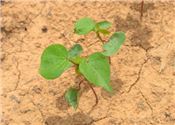Cotton Acreage Increases, Exceeding Early Estimate

Cotton thrives in a Hinds County, Mississippi, field on May 24, 2022. Between 90 percent and 95 percent of the state’s crop was planted as of May 23.
Photo by Mississippi State University Extension Service/Susan Collins- Smith
SUSAN M. COLLINS-SMITH
RAYMOND, MISSISSIPPI
Early May delivered favorable weather conditions for most of Mississippi’s cotton producers, allowing them to get their crops in the ground at the ideal time.
“We’re getting close to having 100% of the crop planted,” said Brian Pieralisi, Mississippi State University Extension Service cotton specialist and researcher with the Mississippi Agricultural and Forestry Experiment Station. “I’d say we’re between 90 percent and 95 percent planted.
“We haven’t seen that in the last few years because of the weather.
But we had two or three weeks of good weather during that optimal planting window between May 1 and 10. A lot of growers were finished by May 10,” he said.
Some acreage in the far north, far south and the Delta account for the unplanted acres as of May 23. Areas in the north and south were a little too dry, while a sandblasting event destroyed some young plants north of Highway 82 in Bolivar and Coahoma Counties.
Pieralisi said he expects those areas to be planted and replanted within the next two weeks.
Overall, the crop looks good, he said.
“Right now, we’re concentrating on thrips [insect pests], but it’s nothing out of the ordinary,” Pieralisi said. “They can be aggressive, but there were a lot of pesticide applications going out in the first couple of weeks after planting. At the three- or four- week stage, we’ll be out of the danger zone on that. And we’re almost there.
“We’re off to a pretty good start. I haven’t heard any major complaints,” he said.
A USDA National Agricultural Statistics Service report for the week ending May 22 estimates that 52 percent of the cotton crop has emerged. Sixty-one percent of the crop is in good condition, 20 percent is in fair condition, and 12 percent is in excellent condition.
Pieralisi said he expects total cotton acreage in the state to surpass the USDA’s projection of 500,000 acres. That estimate is up 11 percent from the 450,000 acres planted in 2021.
“It looks like we’ll have somewhere between 525,000 and 550,000 acres,” he said. “I don’t have a final count on that yet, but I think we’ll be in that range.”
A wet spring delayed planting in 2021, which caused some growers to plant soybeans on acreage originally intended for cotton. Part of the increase in 2022 cotton acreage reflects growers getting back to that 2021 intended acreage. High commodity prices also played a part, Pieralisi said.
While plants have just emerged, Pieralisi said everything is going well.
“We’ve been able to fertilize on time. Weeds are under control. We have a good handle on those kinds of things,” he said. “But you always worry about what might be coming.”
Will Maples, Extension agricultural economist, said prices are good.
December futures, which represent the price for the new crop, are currently trading around $1.25 per pound. USDA estimates the farm price at 90 cents per pound for the 2022--2023 marketing year.
However, prices could go higher if drought conditions in the U.S.
Southern Plains worsen.
“This region of West Texas and Oklahoma typically accounts for 40 percent to 45 percent of U.S. acreage, but they are facing the possibility of a record drought,” Maples said.
Nationwide, USDA estimates 12.23 million acres of cotton will be planted – 1 million more than in 2021. However, the drought has production projections reduced by a million bales.
“How high these dry conditions can push prices is dependent on demand,” Maples said. “We are seeing mills slow down purchases due to a combination of high prices and a slowing world economy.” ∆
SUSAN M. COLLINS-SMITH: MSU Extension Service